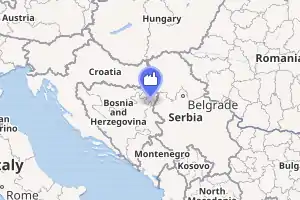Ugljevik Power Plant
The Ugljevik Power Plant (Serbian: Термоелектрана "Угљевик") is a coal-fired power plant in Ugljevik, Bosnia and Herzegovina. It is owned and operated by Rudnik i termoelektrana Ugljevik, a subsidiary of Elektroprivreda Republike Srpske. RiTE Ugljevik is an integrated coal-mining and power generating company.
| Ugljevik Power Plant | |
|---|---|
 Ugljevik Power Plant | |

| |
| Official name | Термоелектрана "Угљевик" |
| Country | Bosnia and Herzegovina |
| Location | Ugljevik |
| Coordinates | 44°40′55″N 18°58′2″E |
| Status | Operational |
| Construction began | 1976 |
| Commission date | 1985 |
| Owner(s) | Elektroprivreda Republike Srpske |
| Operator(s) | Rudnik i termoelektrana Ugljevik |
| Thermal power station | |
| Primary fuel | Coal |
| Cogeneration? | Yes |
| Power generation | |
| Units operational | 1 X 300 MW |
| Make and model | LMZ Electrosila Končar[1] |
| Nameplate capacity | 300 MW |
| External links | |
| Commons | Related media on Commons |
History
Ugljevik has been coal mining area since 1899. Construction of the coal-fired power plant started in 1976 and the first and only unit was commissioned in 1985.[1] At the same time, the old Ugljevik coal mine was closed, the new Bogutovo Selo mine was opened, and the integrated coal-mining and power generating company RiTE Ugljevik was created on the base of Rudnik Ugljevik mining company.
Construction of the second unit started in 1985 and halted during the Bosnian War.[1] During the war, the power plant was closed from April 1992 to November 1995, though the facilities and equipment were saved in expectation of resuming production.
In 2010, the power plant went through extensive upgrading,[2][3] the power plant nevertheless remaining a major source of pollution for the whole Western Balkan region and beyond.
Description

The Ugljevik Power Plant is now one of the largest generators of electricity in Republika Srpska. It has a combined heat and power generation unit with an installed capacity of 300 MW.[1] In 2009, it generated 1,559 GWh of electricity and consumed 1.3 million tonnes of coal.[4]
The power plant has a 310-metre (1,020 ft) tall flue gas stack, the tallest structure in Bosnia and Herzegovina. Before the Bosnian War on the top of chimney with big white letters was written 'TITO', in memory of communist leader of former Yugoslavia Josip Broz Tito. During the war text was rewritten, so now is visible a Serbian symbol, the Serbian cross.
The company plans to open a new coal mine, Ugljevik-Istok.[2] Some investors have showed interest in building a second unit with capacity of 600 MW of electricity.
The power plant is also infamously known as a one-of-a-kind polluter: it emits large amounts of dangerous sulphur dioxide compared to its relatively limited power generation capacity,[5] and, as of April 2019, there was still no operational flue gas desulfurization unit.[6] For this reason, the Uglevik power plant is also sometimes seen as a "Chernobyl of Europe".[7]
See also
References
- "Coal-Fired Plants in Bosnia & Montenegro". industcards.com. Archived from the original on 2009-07-18. Retrieved 2011-01-02.
- "Bosnia's Ugljevik Power Plant To Spend 25.6 Mln Euro on Upgrades in 2010 - Media". SeeNews. 2010-02-08. Archived from the original on 2011-07-16. Retrieved 2011-01-02.
- Bajtarević, Mirsad (2010-08-13). "Repair and maintenance works in Ugljevik mine and power plant are being conducted according to the plans". Energetika.net. Retrieved 2011-01-02.
- Stanic, Olja; Zuvela, Maja (2010-03-18). "Bosnia utility EPRS posts record '09 output, profit". Reuters. Retrieved 2011-01-02.
- "Chronic coal pollution - EU action on the Western Balkans will improve health and economies across Europe" (PDF). HEAL, CAN Europe, Sandbag, CEE Bankwatch Network and Europe Beyond Coal. 2019-02-19. Retrieved 2019-04-25.
- "First Flue Gas Desulfurization System in the West Balkans supplied for Ugljevik Thermal Power Plant in Bosnia and Herzegovina". Mitsubishi Hitachi Power Systems. 2016-07-21. Retrieved 2019-04-25.
- "'Chernobyl of Europe' claimed to be main cause of death in a part of Bosnia". N1. 2019-02-21. Retrieved 2019-04-25.
External links
| Wikimedia Commons has media related to Ugljevik Power Plant. |